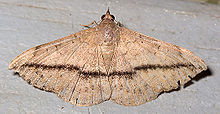
The Catocalini are a tribe of moths in the family Erebidae. Adults of many species in the tribe are called underwing moths due to their vividly colored hindwings that are often covered by contrastingly dark, drab forewings.

The Ophiusini are a tribe of moths in the family Erebidae.

The Phaegopterina are a subtribe of tiger moths in the tribe Arctiini, which is part of the family Erebidae. The subtribe was described by William Forsell Kirby in 1892. 469 species of Phaegopterina are present and 52 that are recently discovered in Brazil.

The Herminiinae are a subfamily of moths in the family Erebidae. The members of the subfamily are called litter moths because the caterpillars of most members feed on dead leaves of plants, though others feed on living leaves, and/or the mushrooms of fungi as in the case of genus Idia.

The Aganainae are a small subfamily of moths in the family Erebidae. The adults and caterpillars of this subfamily are typically large and brightly colored, like the related tiger moths. Many of the caterpillars feed on poisonous host plants and acquire toxic cardenolides that make them unpleasant to predators. Like the closely related litter moths, the adults have long, upturned labial palps, and the caterpillars have fully or mostly developed prolegs on the abdomen. The Aganainae are distributed across the tropics and subtropics of the Old World.
Mursa is a genus of moths of the family Erebidae.
Allerastria is a genus of moths of the family Erebidae.
Bandelia is a genus of moths of the family Erebidae.
Phlyctaina is a monotypic litter moth genus of the family Erebidae. Its only species, Phlyctaina irrigualis, is found in North America. Both the genus and species were first described by Heinrich Benno Möschler in 1890.

Baniana gobar is a species of moth of the family Erebidae first described by Herbert Druce in 1898. It is found in Mexico.

Hypocalinae is a subfamily of moths in the family Erebidae.

The Anobinae are a subfamily of moths in the family Erebidae described by Jeremy Daniel Holloway in 2005. Common morphological characteristics of Anobine moths include a dark head and prothoracic collar, lighter color on the thorax, and either bipectinate antennae or antennae with flagellomeral setae in males.

The Boletobiinae are a subfamily of moths in the family Erebidae, containing about 956 species. The taxon was described by Achille Guenée in 1858.

The Hypenodinae are a subfamily of moths in the family Erebidae. Adult moths of most species of this subfamily lack small, simple eyes near the large, compound eyes and have quadrifine (four-veined) hindwing cells. The micronoctuid moths are an exception because they possess simple eyes and bifine (two-veined) hindwing cells.

The Scoliopteryginae are a subfamily of moths in the family Erebidae. Larvae have distinctive, extra setae on the first through seventh abdominal segments. Many adult moths in the subfamily have a proboscis adapted to pierce fruit skin, allowing consumption of the juice in the fruit.

The Rivulinae are a subfamily of moths in the family Erebidae described by Augustus Radcliffe Grote in 1895. Caterpillars in the subfamily typically have long, barbed hairs and have full prolegs on abdominal segments 3 through 6. The adults have a unique microsculpturing proboscis.

The Scolecocampinae are a subfamily of moths in the family Erebidae. The taxon was erected by Augustus Radcliffe Grote in 1883.
The Toxocampinae are a subfamily of moths in the family Erebidae. Moths in the subfamily typically have a primitive form of genital claspers similar to those of some subfamilies of the Noctuidae.
The Omopterini are a tribe of moths in the family Erebidae.
Deinopa angitia is a species of moth in the family Erebidae first described by Herbert Druce in 1891. It is found in Central and North America.













